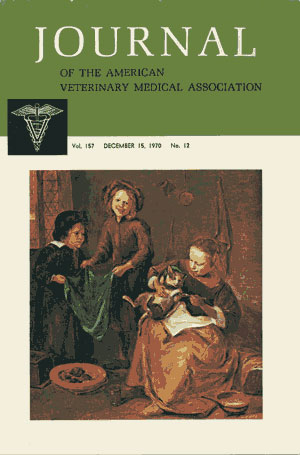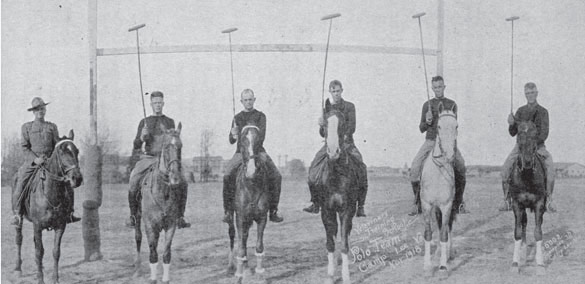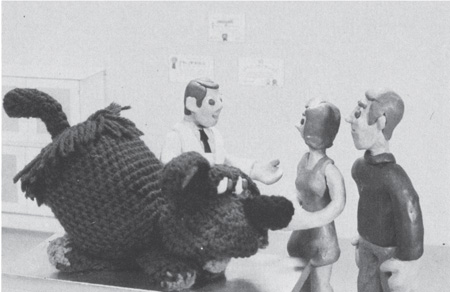Et cetera
Covering the full extent of JAVMA’s 100 years would be an impossible task, so we focused our coverage of each decade on the most notable events in veterinary medicine and major changes to the Journal. During the course of our research, we ran across many interesting or peculiar items that didn’t make the cut for the summaries. Here are a few, for your reading pleasure.
See the Photo Gallery

An August 1917 letter to the editor read:
Dear Sir:
Will you kindly permit me (as editor of the Veterinary Journal) to send a message through you (the editor of the Journal of the American Veterinary Medical Association) to my brother members of the association to welcome them as Allies in this terrible war; and to say that the British Veterinary Profession will extend the cordial hand of welcome to an American Colleague wherever we may meet in the fight for freedom and liberty, and for the rightings of the wrongs of the weaker and smaller nations who have been so ruthlessly crushed.
Frederick Horday, FRCVS, FRSE
Major Army Veterinary Corps
Honorary Veterinary Surgeon to His Majesty the King
(Note: Prohibition began in January 1920 and continued through 1933.)
A September 1920 article titled “No Whiskey For Animals” reported:
A member of the American Veterinary Medical Association requested me to find out if veterinarians could prescribe alcoholic liquors for their animal patients. This matter was taken up with the Bureau of Internal Revenue and the following reply was received: “Replying to your communication of June 16, 1920, you are informed that veterinarians may not prescribe intoxicating liquors for internal use for their animal patients. Under the statute the right to prescribe intoxicating liquors for internal use for medicinal purposes is limited to duly qualified physicians for persons only. Not to exceed 6 quarts of alcohol may therefore be obtained by any veterinarian during any calendar year to be obtained and used as provided by Regulation 60.”
N. S. Mayo, Secretary

During the Great Depression, veterinarians did their part by participating in the Civilian Conservation Corps. This was a public works relief program that operated from 1933-1942 as part of the New Deal for unemployed, unmarried men from families on government relief. The program’s director was quoted in JAVMA as saying that from 1933-1937 up to 115 veterinary reserve officers inspected food for program camps, which employed 2 million people.
The AVMA House of Delegates considered changing membership requirements in 1935 to allow for nonveterinarians. Obviously, the proposal didn’t pass.
The AVMA Committee on History reported in 1945: “Much of the history of veterinary medicine in America has been recorded in the journals as ‘on the spot’ news, but has not been assembled as a history because that would be difficult, discouraging, baffling, and time-consuming ... [and] would not sell for enough money to make the project worthwhile.”
In his 1945 AVMA presidential address, Dr. James Farquharson dealt with frequently voiced criticisms. In answer to “What has the AVMA ever done for me?” he said that many members “have the idea that our central office does nothing more than operate a printing press of the Journal!” Dr. Farquharson also voiced a recurring desire for the AVMA to publish something similar to “Hygeia,” the lay publication of the American Medical Association, which ran from 1923-1949. Then from 1950-1976, it was published under the name “Today’s Health.”

Researchers fed whale meat to minks in a search for food that would boost the minks’ libidos, fertility, litter sizes, or offspring weights. They found no significant differences from those fed horse meat, and the small account published in the Feb. 15, 1957, issue of JAVMA gave no indication how the results would have been used had a difference been found.

A JAVMA editorial responded, without condemnation, to photos of President Lyndon Johnson lifting a Beagle by its ears. The Aug. 15, 1964, editorial stated that pulling on a Beagle’s ears to make it yip may be a useful technique for trainers, but owners should “let their dog’s ears alone.”
Live veterinary surgical demonstrations captivated audiences in September 1970 at the New York State Fair in Syracuse. Upward of 15,000 people packed an amphitheater—and others were turned away—to watch the 28 surgeries sponsored by the New York State Veterinary Medical Society and performed on animals selected through referrals.
Numbering 602 pages, the Dec. 1, 1970, issue of the JAVMA was the largest in the Journal’s history. Stripped of almost all its usual editorial and news content, the issue was devoted to the scientific proceedings of the 107th Annual Meeting of the AVMA. Although five times the size of a typical issue, it was produced and mailed to subscribers almost on schedule. The printer used two boxcars of paper, exclusive of cover paper, to print the book. Sixteen days were required to print the entire issue. Six days were consumed in the bindery.

In 1979, AVMA President-elect William F. Jackson escaped from his car just before it was hit by a train and exploded, while on a call to test a client’s bulls.
In the May 15, 1996, issue, JAVMA reported on “Managing your economic future in veterinary medicine,” an AVMA symposium addressing “soaring” veterinary student debt.
Sarajevo University Faculty of Veterinary Medicine graduated 95 veterinarians on Dec. 12, 1996, after a 15-year hiatus during the civil war that rocked the Balkans.
A Jan. 1, 1999, JAVMA article examined fears about the Y2K bug and the likelihood of it causing a global economic crash.

Carbon Copy, the first cloned kitten, was born at Texas A&M University Dec. 22, 2001. CC was a perfect genetic match of its donor, Carbon.